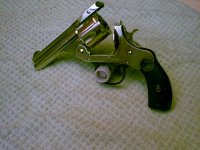I picked up a used one in VG condition a couple of weeks ago (nickel plated). It is an auto eject model with a 3.25" barrel. It is marked 32 S&W on the barrel and the Blue book lists the model as .32 S&W as well. Earlier models were made in both .32 S&W and Longs. I had a box of .32 S&W longs sitting around, so I stick one in the cylinder and it chambers fine.
Do you think this gun was designed to shoot both. Is it safe to do so if it is in good mechanical shape?
Also - Were these guns designed to be carried on half cock?
Do you think this gun was designed to shoot both. Is it safe to do so if it is in good mechanical shape?
Also - Were these guns designed to be carried on half cock?

